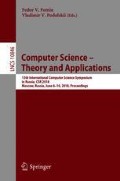Abstract
We study upper and lower bounds for the problem of maintaining a chordal graph G under edge insertions and deletions. Let G be a chordal graph on n vertices and m edges and let (u, v) be the edge to be deleted or inserted.
-
Let k be the size of the maximum clique in G. Our first result is an improved analysis of an earlier approach due to Ibarra [12] to support edge deletions. We can construct a data structure in \(O(nk^2)\) time such that we can report in O(1) time if \(G{\setminus }{(u,v)}\) is chordal and if it is, we can update the structure in \(O(n + k^2)\) time. We then show using a charging argument that the update time can be improved to \(O(n^2/\Delta + k^2)\) amortized time over a sequence of \(\Delta \) deletions.
-
We develop a data structure to maintain a perfect elimination ordering (PEO) of chordal graphs where we can detect whether \(G{\setminus }{(u,v)}\) is chordal in \(O(\min \{degree(u), degree(v)\})\) time, and if it is chordal, we can update the structure in \(O(degree(u)+degree(v))\) time. In graphs of bounded degree, our query and update bounds are a constant.
-
Finally, we show that we can obtain a PEO of the graph from a clique-tree in O(n) time after an edge insertion or deletion (against a naive \(O(m\,+\,n)\) time). This answers a question posed by Ibarra [12].
Regarding lower bounds, we show that any dynamic structure to maintain a chordal graph requires \(\varOmega (\log n)\) amortized time per edge addition or deletion or per query to detect chordality, in the cell probe model with word size \(\log n\).
Access this chapter
Tax calculation will be finalised at checkout
Purchases are for personal use only
Notes
- 1.
Proof deferred to the full version.
- 2.
Proof deferred to the full version.
References
Berry, A., Sigayret, A., Spinrad, J.: Faster dynamic algorithms for chordal graphs, and an application to phylogeny. In: Kratsch, D. (ed.) WG 2005. LNCS, vol. 3787, pp. 445–455. Springer, Heidelberg (2005). https://doi.org/10.1007/11604686_39
Brandstädt, A., Dragan, F.F., Chepoi, V., Voloshin, V.I.: Dually chordal graphs. SIAM J. Discrete Math. 11(3), 437–455 (1998)
Buneman, P.: A characterisation of rigid circuit graphs. Discrete Math. 9(3), 205–212 (1974)
Deshpande, A., Garofalakis, M.N., Jordan, M.I.: Efficient stepwise selection in decomposable models. In: UAI 2001: Proceedings of the 17th Conference in Uncertainty in Artificial Intelligence, University of Washington, Seattle, Washington, USA, 2–5 Aug 2001, pp. 128–135 (2001)
Diestel, R.: Graph Theory. GTM, vol. 173, 4th edn. Springer, Heidelberg (2012)
Dietz, P.F., Sleator, D.D.: Two algorithms for maintaining order in a list. In: Proceedings of the 19th Annual ACM Symposium on Theory of Computing 1987, New York, NY, USA, pp. 365–372 (1987)
Fagin, R.: Degrees of acyclicity for hypergraphs and relational database schemes. J. ACM 30(3), 514–550 (1983)
Gavril, F.: Algorithms for minimum coloring, maximum clique, minimum covering by cliques, and maximum independent set of a chordal graph. SIAM J. Comput. 1(2), 180–187 (1972)
Hell, P., Shamir, R., Sharan, R.: A fully dynamic algorithm for recognizing and representing proper interval graphs. SIAM J. Comput. 31(1), 289–305 (2001)
Henzinger, M.R., Fredman, M.L.: Lower bounds for fully dynamic connectivity problems in graphs. Algorithmica 22(3), 351–362 (1998)
Howorka, E.: A characterization of ptolemaic graphs. J. Graph Theory 5(3), 323–331 (1981)
Ibarra, L.: Fully dynamic algorithms for chordal graphs and split graphs. ACM Trans. Algorithms 4(4), 40:1–40:20 (2008)
Mezzini, M.: Fully dynamic algorithm for chordal graphs with O(1) query-time and O(n\({}^{2})\) update-time. Theor. Comput. Sci. 445, 82–92 (2012)
Mezzini, M., Moscarini, M.: Simple algorithms for minimal triangulation of a graph and backward selection of a decomposable markov network. Theor. Comput. Sci. 411(7–9), 958–966 (2010)
Nesetril, J.: Structural properties of sparse graphs. Electron. Notes Discrete Math. 31, 247–251 (2008)
Patrascu, M., Demaine, E.D.: Logarithmic lower bounds in the cell-probe model. SIAM J. Comput. 35(4), 932–963 (2006)
Rose, D.J., Tarjan, R.E., Lueker, G.S.: Algorithmic aspects of vertex elimination on graphs. SIAM J. Comput. 5(2), 266–283 (1976)
Tarjan, R.E., Yannakakis, M.: Simple linear-time algorithms to test chordality of graphs, test acyclicity of hypergraphs, and selectively reduce acyclic hypergraphs. SIAM J. Comput. 13(3), 566–579 (1984)
Walter, J.R.: Representations of chordal graphs as subtrees of a tree. J. Graph Theory 2(3), 265–267 (1978)
Yao, A.C.-C.: Should tables be sorted? J. ACM 28(3), 615–628 (1981)
Acknowledgement
The first author would like to thank Keerti Choudhary for useful discussions leading to Theorem 5.
Author information
Authors and Affiliations
Corresponding author
Editor information
Editors and Affiliations
Rights and permissions
Copyright information
© 2018 Springer International Publishing AG, part of Springer Nature
About this paper
Cite this paper
Banerjee, N., Raman, V., Satti, S.R. (2018). Maintaining Chordal Graphs Dynamically: Improved Upper and Lower Bounds. In: Fomin, F., Podolskii, V. (eds) Computer Science – Theory and Applications. CSR 2018. Lecture Notes in Computer Science(), vol 10846. Springer, Cham. https://doi.org/10.1007/978-3-319-90530-3_4
Download citation
DOI: https://doi.org/10.1007/978-3-319-90530-3_4
Published:
Publisher Name: Springer, Cham
Print ISBN: 978-3-319-90529-7
Online ISBN: 978-3-319-90530-3
eBook Packages: Computer ScienceComputer Science (R0)

